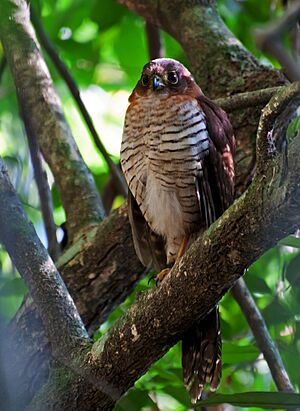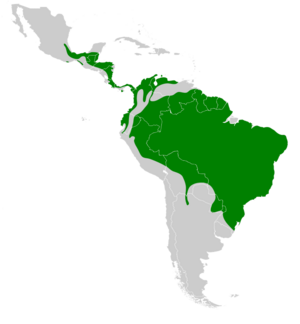Barred forest falcon facts for kids
Quick facts for kids Barred forest falcon |
|
|---|---|
 |
|
| In São Paulo, Brazil | |
| Conservation status | |
| Scientific classification | |
| Genus: |
Micrastur
|
| Species: |
ruficollis
|
 |
|
The barred forest falcon (scientific name: Micrastur ruficollis) is a cool bird of prey. It's part of the Falconidae family, which includes falcons and caracaras. You can find this bird in many places! It lives from southern Mexico all the way down through Central America. In South America, it's found in almost every country, except for Chile and Uruguay.
Contents
About the Barred Forest Falcon
Different Types of Barred Forest Falcons
Just like there are different breeds of dogs, there are different types of barred forest falcons called subspecies. These are slightly different groups within the same species. There are six known subspecies of the barred forest falcon:
- M. r. guerilla
- M. r. interstes
- M. r. zonothorax
- M. r. concentricus
- M. r. ruficollis
- M. r. olrogi
Did you know? Another bird, the lined forest falcon, used to be thought of as a subspecies of the barred forest falcon, but now scientists know it's its own separate species!
What Does It Look Like?
The barred forest falcon is about 31 to 39 centimeters (12 to 15 inches) long. That's about the length of a school ruler! Males weigh around 144 to 184 grams (5 to 6.5 ounces), and females are a bit heavier, weighing 200 to 322 grams (7 to 11 ounces).
Most of these falcons have dark gray feathers on their backs. Their tail has a white tip and usually three to six thin white stripes. Their throat is light gray, and the rest of their belly and under their wings are white with thin black or dark gray stripes. The top part of their chest is a darker gray.
Some barred forest falcons, especially one subspecies called M. r. zonothorax, can look different. Some are gray, but others can be brown or reddish-brown instead! This is called being polymorphic, meaning they have different color forms. The subspecies M. r. ruficollis is usually only reddish-brown, which is why its scientific name includes "ruficollis," meaning "red-necked."
Their eyes can be cream or light orange-brown. Their beak is black, turning yellow at the bottom. Their legs are orange-yellow.
Where Do They Live?
Barred forest falcons live in different parts of the Americas. Each subspecies has its own area:
- M. r. guerilla lives from central Mexico down to Nicaragua.
- M. r. interstes is found from Costa Rica through Panama, western Colombia, and western Ecuador into Peru.
- M. r. zonothorax lives in parts of Venezuela, Colombia, Ecuador, Peru, and Bolivia.
- M. r. concentricus is found in southern Venezuela, the Guianas, and the Amazon area of Brazil.
- M. r. ruficollis lives in Brazil (south of the Amazon), Paraguay, and parts of Argentina.
- M. r. olrogi is found in northwestern Argentina.
These falcons mostly live in old, grown-up forests. In Central America, they prefer tropical forests. But in South America, they can live in other kinds of forests too, even drier ones. They might be found in forests that are growing back after being cut down, or along riverbanks. They generally avoid places where humans have changed the land too much. They need primary (original) or mature secondary (older regrown) forests to survive.
They can be found at different heights in the mountains. For example, in Colombia, they've been seen in primary and old secondary forests between 3,300 and 4,900 meters (10,800 and 16,000 feet) high!
Barred Forest Falcon Behavior
Staying Put
The barred forest falcon usually stays in the same area all year round. It doesn't migrate like some other birds.
What Do They Eat?
These falcons are hunters! They eat all sorts of small animals like lizards, small birds, and small mammals. This includes rodents and even tiny marsupials like opossums. They also hunt bats, snakes, and frogs.
How do they hunt? They often sit quietly on tree branches, waiting for their prey to show up. When an animal comes close, they quickly swoop down to catch it. They can also chase prey on foot, follow swarms of army ants (which stir up other small animals), or even snatch animals from traps!
Family Life
In Guatemala, the barred forest falcon's breeding season is from mid-April to early August. They build their nests in holes in trees, usually natural ones, but sometimes old woodpecker holes. These nests are often high up, about 10 to 30 meters (33 to 98 feet) above the ground.
Once they find a partner and a nesting spot, they tend to stick with them! The female lays two to six eggs, and she does all the incubating (keeping the eggs warm). This takes about 33 to 35 days. After the chicks hatch, it takes about 38 days for them to be ready to fly. Both parents bring food to the nestlings, but the male usually brings about two-thirds of the food.
What Do They Sound Like?
The barred forest falcon has some interesting calls! One of its main calls sounds like a dog's yap, like "keyak" or "ark." Another call sounds like a bouncing ball, like "cah cah cah-cah-cah." When two males are arguing, one might make a fast chittering sound, while the other makes a quick clucking noise.
Status of the Barred Forest Falcon
The IUCN (International Union for Conservation of Nature) says the barred forest falcon is a species of "Least Concern." This means they are not currently in danger of disappearing. They live across a very large area, and there are at least half a million adult birds. Even though their numbers might be slowly going down, scientists haven't found any big, immediate threats to them right now.


